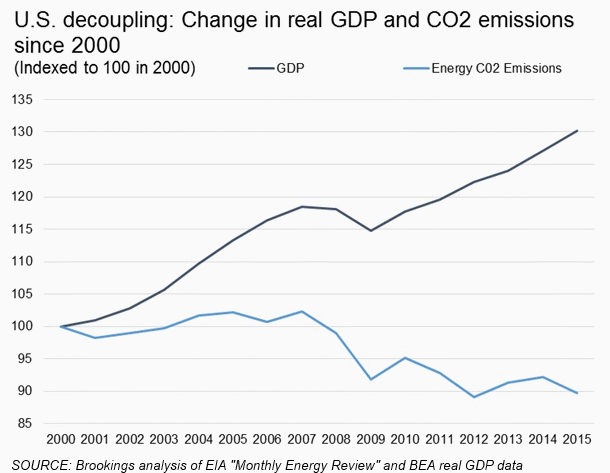I know a nine-degree day in Aberdeen is not the best day to talk about global warming. I should have posted on climate change on November 5, when I was campaigning door-to-door on my bike in a t-shirt and shorts.
But with the President-Elect threatening to order NASA to stop studying Earth, even though Earth science is the top line in NASA’s charter, to throttle the flow of data that renders his incoming oil-pal EPA chief’s climate-change denial untenable (what’s next, burning books?), we should note a new report that shows that fighting climate change does not stop economic growth:
A new Brookings Institution report compares state’s recent economic growth to changes in carbon emissions. In all, 33 states and the District of Columbia achieved reductions in emissions while expanding their economies between 2000 and 2014. The others saw their emissions continue to rise [Mike Maciag, “Most States Are Combating Climate Change and Growing Their Economies,” Governing, 2016.12.08].
But Brookings Institution author Mark Muro notes that renewable energy has less to do with this decoupling of carbon emissions and economic growth than to fracking and (Merry Christmas, Dr. McTaggart) nuclear power!
The single largest driver of emissions reductions, according to Muro, is the shift from coal to natural gas, a result of the recent fracking boom. This is particularly true in the Northeastern states, which are generating more power from natural gas while also importing hydroelectric power from Canada.
Zero-emissions nuclear power plants, while not as prevalent, also played a role in pushing down emissions. In the Northeast, nuclear plants were responsible for 35 percent of electricity generation in 2014, the most of any region, according to Brookings. A slew of Southern states also experienced sizable expansions, such as North Carolina and Tennessee. Thirty-two states currently have at least a limited presence of nuclear power generation.
The study did not find a strong statistical relationship between states’ emissions reductions and use of wind or solar power generation. A select few Western states experienced sizable gains in wind generation. Still, though, the recent growth of renewables has yet to register as having a major effect on emissions nationally [Maciag, 2016.12.08].
That conclusion doesn’t say renewables are a waste of time; it just suggests that we haven’t used or expanded renewables enough for them to make a dent in emissions.
The main takeaway here is that policies to curb climate change and policies to promote jobs and GDP do not mutually exclude. We don’t have to go back to coal (and the market and China say we won’t) and send hip-waders to Florida to keep our economy humming.
Now hang in there—I’m sure we’ll get another warm spell over Christmas break.
P.S.: According to Maciag, South Dakota has reduced its carbon emissions since 2000 by 2.2% a year, the same rate as California, West Virginia, Indiana, and Wyoming. North Dakota, with all of its Bakken oil and gas production, leads the nation in carbon emission reductions at 5.5% a year.

My pipes were frozen this morning. Fortunately the landlord doesn’t charge me to defrost them. He was behind in winterizing my pipes and basement door this year. We won’t see below zero temps until next week.
With grid upgrades, it’s possible. With Republican opposition, it isn’t.
https://www.facebook.com/solarcity/videos/10154097100265011/
Fortunately we don’t have to worry about global warming for the next 4 years. It’s a Chinese hoax according to President-Elect Trump.
Burning coal kills fish and pheasants.
Well…I didn’t expect to find that in my stocking ;^).
We do need to do a better job at using renewables as they are…can’t count on energy storage to magically occur. The more we can shift demand (or dedicate certain demands) to when they are prominent, the greater the carbon reduction power of renewables.
http://abcnews.go.com/US/wireStory/energy-company-plan-close-michigan-nuclear-plant-2018-44058392
Oops, there goes another nuclear plant…
…to be replaced by renewables plus natural gas. So Michigan will be emitting more carbon.
http://www.csmonitor.com/Environment/2016/1208/How-natural-gas-and-nuclear-have-made-the-US-greener-times-two
This article goes over the same study that Cory refers to, but there is a video at the bottom claiming that solar power is about to finally break even on emissions. That is probably one reason there hasn’t been a big decrease from using solar yet.
Funny, Ror—in China, certain left-wing radicals contend that climate change is a hoax perpetrated by Western imperialists to enslave China.
science, data, statutory requirements, Supreme Court precedents, existing regulations, state progress and the huge clean energy industrial sector will constrain regulatory rollbacks or the wholesale loss of progress to slow climate change. Under the Constitution and rule of law, change by presidential fiat is not an option.
William W. Buzbee is a professor at the Georgetown University Law Center. http://www.nytimes.com/2016/12/08/opinion/dismantling-climate-rules-isnt-so-easy.html?action=click&pgtype=Homepage&clickSource=story-heading&module=opinion-c-col-left-region®ion=opinion-c-col-left-region&WT.nav=opinion-c-col-left-region
There is zero debate in the scientific community that if it’s going to get warmer, Greenland is going to melt. And sitting in Greenland are the equivalent of seven meters (23 feet) of sea level rise,” Bierman told Popular Science. http://www.csmonitor.com/Environment/2016/1207/For-millions-of-years-Greenland-had-almost-no-ice
a couple of centuries to a couple of millennia are the fastest meltdown scenarios….Many parts of the world will be hard-pressed to adapt to the 3-4 feet of sea level rise projected for 2100 by the IPCC, and the IPCC report doesn’t account for a potentially rapid meltdown of Greenland ice
https://insideclimatenews.org/news/07122016/greenland-ice-melting-climate-change
Doc-closure of a MI nuke plant may make it safer for local residents and that “trade-off” of natl gas emissions plus renewables is necessary to get to the goal of stemming climate change.
Guys, look At Slate.com Anti-trump Headlines Today. Hilarious.